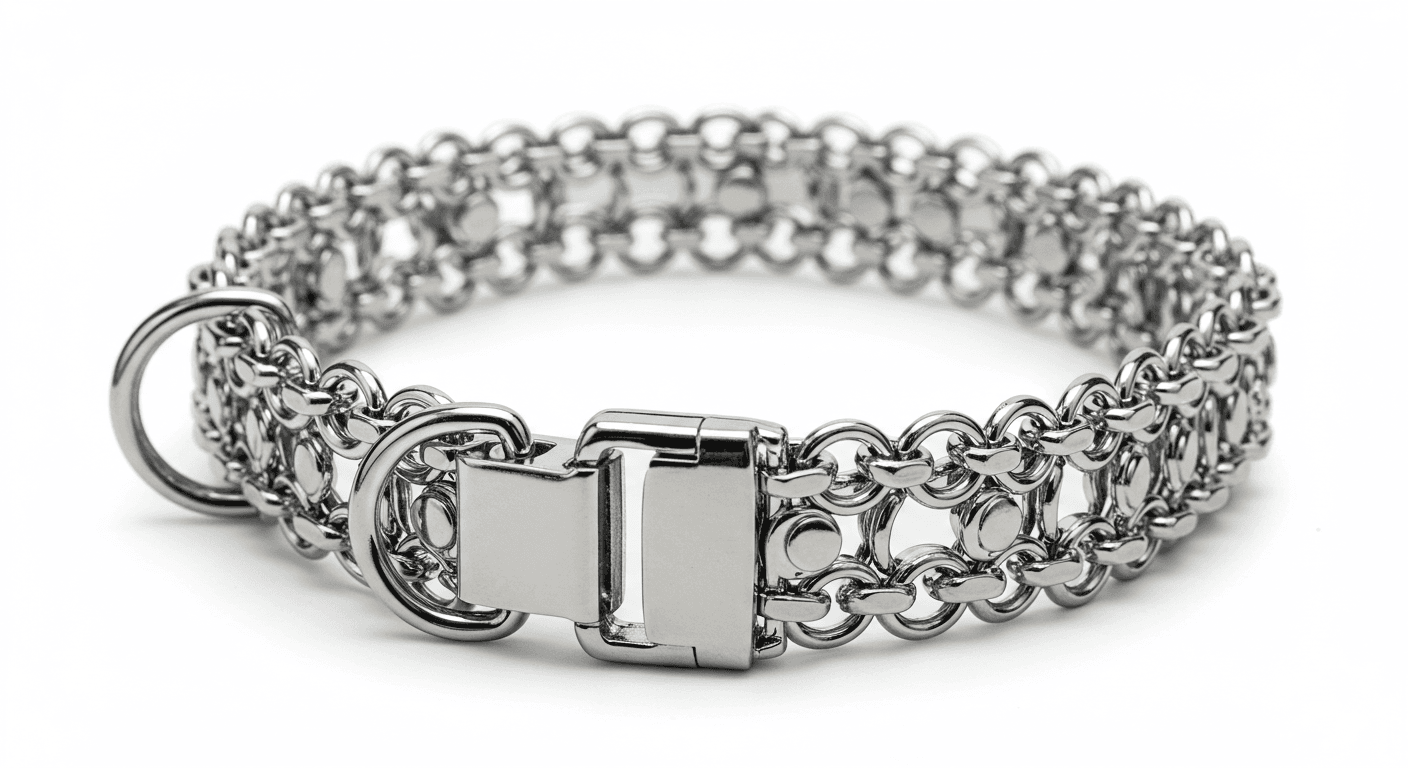If you’ve ever caught yourself asking, “are prong collars cruel?”, trust me, you’re not alone. Lots of dog owners wrestle with this question, especially when they’re struggling with a strong puller on the other end of the leash. It’s tough to sort through all the conflicting advice floating around. That’s why I’ve put together this comprehensive guide: to help you understand the ins and outs of prong collars, how they work, whether they’re safe, and of course if do prong collars hurt dogs. By the end, you’ll have what you need to make a choice that feels right for you and your furry friend.
Understanding Prong Collars for Dogs

Before forming any hard and fast opinions, let’s talk about what a prong collar (also called a pinch collar) actually is. These collars for dogs are typically metal with interlinked segments, each ending in blunt prongs. When a dog pulls, those prongs tighten around the neck.
People who support prong collar training say that this design spreads out pressure more evenly than a regular flat collar, which can be a plus for strong pullers. Some even claim it mimics how a mother dog corrects her pup. Critics argue the collar is naturally aversive, focusing on pain or discomfort, and can put the dog’s physical and emotional well-being at risk.
Let’s be real: the bigger question isn’t just how these collars look, it’s how they affect your dog’s welfare, your training goals, and the relationship you share.
The TRUTH about Spiked Collars (Sizes, Brands, Cuts, and Myths)
Are Prong Collars Cruel? The Evidence
At the heart of this debate is whether prong collars are cruel and, more specifically, do prong collars hurt dogs physically or emotionally. Let’s break down the science and expert views.
Physical Risks
When we talk about prong collars for dogs, some people say that if you use them correctly, meaning proper fit, short training sessions, and careful handling, the risk of major injury is low. But multiple veterinary and animal welfare groups warn about the following:
- Bruises, punctures, or skin abrasions: Prongs can hurt the dog’s neck if used incorrectly or for too long.
- Pressure on sensitive areas: Constant tightening might harm the thyroid, trachea, or spine.
- Potential pain: Even if there aren’t obvious wounds, the collar’s “pinch” is meant to feel uncomfortable.
- Long-term harm if misused: Leaving a prong collar on a dog for extended periods can lead to infections, scabs, and other serious issues.
Yes, experienced trainers and manufacturers often say proper use is safe, but let’s face it, mistakes happen, especially if you’re new to this.
Emotional and Behavior Effects
We also have to look beyond physical harm. When you ask, “do prong collars hurt dogs?” keep emotional well-being in mind:
- Stress or anxiety: Dogs might start to associate walks, training sessions, or certain triggers with pain.
- Suppressing behavior instead of teaching: Sure, your dog might stop pulling, but that could just be from fear of the collar, not because they’ve learned good leash manners.
- Aggression or withdrawal: Fear-based or defensive aggression and learned helplessness are real possibilities with aversive methods.
Research increasingly shows that aversive tools like a prong dog collar can lead to more serious long-term behavior effects (like anxiety or aggression) than positive reinforcement methods.
Is There an Upside?
Some trainers suggest prong collars for training can offer a quick solution when dealing with big, strong dogs. They also note that in some cases, a prong collar might cause less harm than a choke chain or poorly used flat collar. Still, many modern behaviorists emphasize that safe, positive options exist, and you’ll usually see better, lasting results when you teach a dog what you want instead of forcing them to avoid what you don’t want.
So what’s the real dilemma? It’s deciding whether any short-term gain is worth the potential pain, distress, or damage to the bond you share with your dog.
Opinions from Trainers and Organizations

This topic isn’t just controversial among owners; canine professionals are split on it, too. Here’s how the conversation often goes:
Prong Collar Supporters
- Believe in careful, compassionate use by trainers who know what they’re doing.
- Argue that a prong collar distributes pressure more safely than some other tools.
- Insist that misuse—rather than the collar itself, is the real problem.
- Say that for some dog-owner pairs, this tool might be the only thing preventing a dog from being surrendered or euthanized.
Prong Collar Critics
- Most vets, humane societies, and animal welfare organizations advise against prong collars for dogs.
- Cite research linking aversive methods to fear, anxiety, and aggression.
- Point to actual cases of physical harm and emotional distress.
- Recommend positive reinforcement and reward-based methods for safer, more effective training.
Legal Perspective
In many places, laws mirror these ethical concerns. Prong collars are banned or restricted across various countries (like parts of Australia and much of Europe). If governments are cautioning against them, it’s because there are more humane alternatives that don’t carry the same risks.
Myths vs. Realities
If you’ve been researching this stuff, you’ve probably stumbled upon plenty of conflicting claims about prong collars for dogs. Let’s clear up the most common myths:
Common Myths
- “Dogs’ necks are too tough, so they don’t feel pain.”
They do feel it. A dog’s neck can be quite sensitive, and the stress response is real. - “It’s the only tool that works for strong dogs.”
Reward-based methods plus smart management can handle any size or breed. - “My trainer says it’s safe if fitted right.”
Even if some trainers still use prong collars, most credentialing bodies today lean towards evidence-based, reward-based methods. - “My dog doesn’t mind wearing it.”
Dogs can’t always tell us how they truly feel. They may learn to put up with discomfort or be too confused to react. - “It’s less harmful than choke or slip collars.”
All aversive tools carry risks. The bigger question is why rely on pain or discomfort at all?
The Real Issue
Yes, your dog might quickly quit pulling on a prong collar on a dog—but that doesn’t mean they’ve actually learned polite leash manners. If you have to keep using a prong collar forever, true training hasn’t really happened.
Kinder Alternatives to Prong Collars

If you feel prong collars for training might be risky, you’ve got other safe, effective, and compassionate routes.
Positive Reinforcement Training
- Focuses on rewarding the good stuff with treats, praise, and play.
- Builds trust rather than fear.
- Supported by years of research.
- Reduces anxiety and aggression over time.
Humane Equipment Options
- Martingale collars: They tighten gently but not enough to choke, and they prevent slip-outs.
- Front-clip harnesses: Great for redirecting pulling without putting pressure on the neck.
- Head halters: Give extra control for strong pullers, though you need patience to introduce them properly.
It’s not about just slapping on a new gadget. Combine kinder tools with positive training for the best results.
Moving Away from a Prong Collar
If you’re using a prong collar right now or know someone who is finding a better option doesn’t have to be a nightmare. Here’s a simple plan:
- Remove the prong collar and switch to a martingale, front-clip harness, or head halter.
- Reward good behavior with treats, praise, and fun activities so your dog enjoys learning.
- Stay calm and consistent, it’ll take time for new habits to form.
- Work with a trainer who specializes in positive reinforcement and can coach you through any challenges.
When people ask, “are prong collars cruel?” the answer can feel complicated. But research, expert advice, and everyday ethics point to one big takeaway: if there’s a chance a tool causes pain, stress, or damages your bond with your dog, it’s probably not the best choice. With so many proven, positive options available, it’s hard to justify the risks.
Remember, when deciding how to train and care for your dog, it boils down to compassion. If you’re thinking, “do prong collars hurt dogs?” and the answer seems to be yes or even maybe consider seeking a better path. Your four-legged friend depends on you for a loving, respectful approach. And chances are, you’ll both be happier for it.



